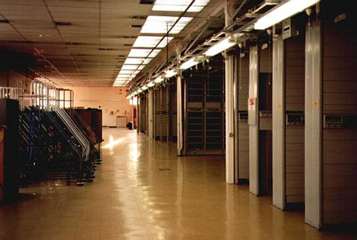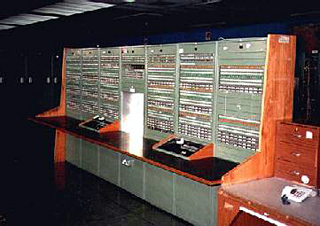 |
Stag Lane was planned and commissioned within only 3 years when it was realised that the equipment destined for installation in Mondial House (which was still being built in 1971) would not be ready to cope with the rapid growth and demand for international calls. Stag Lane, Edgware was the site of a former airfield, hence the ISCs were named after the aircraft industry and the flying pioneers of the Thirties. |
Site History
With RAF Hendon close by, the area is steeped in the history of the early aviators...
Learn about Hendon Aerodrome
Rather less well known is the smaller airfield and factories from which the De Havilland aircraft were built and from which the flying pioneers of the 1930s were trained...
Learn about Stag Lane Aerodrome
International Rescue
In the early 1970s, international call traffic was growing at nearly 20% per annum and to meet the shortfall in both buildings and equipment, an expedient site was urgently needed. By June 1972 a lease had been obtained on the site of a former airfield at Stag Lane...
 |
John Burt, Senior Executive Engineer of the project, recalls how his team came to choose Stag Lane as a major ISC (International Switching Centre). |
Stag Lane consisted of two International Gateways, a Plessey 5005T crossbar (TXK2) called DeHavilland and the Ericsson ARM20 crossbar (TXK5) called Mollison, there were also models of both at the training centre.
Mollison TXK5
BIS date October 1974
The Mollison ISC equipment:
|
By 1989, digital switches were taking over and as Director of Planning BT International, Peter was responsible for the closure of the Crossbar units, but he recalls with a sense of achievement and some modesty...
"Mollison TXK5 was introduced in 1974/5 at Stag Lane, Edgware. This used the LM Ericsson ARM201/202 crossbar system which had separate incoming and outgoing units (the latter switched 10 wires!). It was a simple unit designed to deliver no frills IDD capacity, so couldn't handle transit, operator assistance etc. This unit did 14 years service. Each unit had a capacity of 4000e. At 8000e, Mollison ISC was the world's largest crossbar exchange and largest ISC at the time."
De Havilland TXK2
Project Manager: Pat Hastings [This is being verified]
|
It was 'fully featured' meaning it could handle all types of international calls:
|
"DeHavilland TXK2 was introduced in 1975, also at Stag Lane. It had a capacity of 2500e and was fully featured. DeHavilland was fitted with TXK2 equipment, the ATE 5005T manufactured by Plessey."
Learn more about De Havilland
Misc
The Stag Lane complex also had...
|
|
Stag Lane ISCs closed in late 1989 and the site was sold soon afterwards.
Mr R.W. Button:
Was Deputy Controller of the Project and Works Division in International and Maritime Telecommunications Region, and was involved with the Stag Lane project from the outset. As Stag Lane became operational, he was appointed to head the new Network Control Division of the Post Office's External Telecommunications Executive.
References
POEEJ July 1977 The TXK2 Switching System at Wood Street and De Havilland International Gateway Exchanges by D.C. Modi and K.W. Young.
POEEJ October 1977 The TXK5 Switching System at Mollison and Thames International Gateway Exchanges by P.J.Walker and D.R. Ballinger.
POTJ Spring 1974 Hunt ends at Stag Lane by R.W. Button.
POEEJ October 1976 A New Maintenance Aid for International Exchanges by N.V. West and D.J. Sylvester.
With thanks to: John Burt, Bob Outtram, Peter Walker, and Youngleavers.
All logos and trade marks are the property of their respective owners and are used on the Light Straw site(s) for review only. Students and researchers are recommended to make their own independent enquiries as to the accuracy of the information contained therein.
